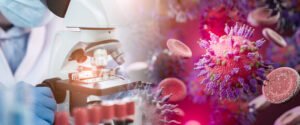Cytology, from the Greek word cyto, which means “cell,” is the study of cells. Every living thing has cells, but not all living things have the same kinds of cells. Eukaryotes like humans (and all other organisms besides bacteria and viruses) have eukaryotic cells, each of which has a defined nucleus that controls and directs the cell’s activities, and cytosol, fluid material found in the gel-like cytoplasm that fills most of the cell. Plant cells have fibrous cell walls; animal cells do not, making do instead with a semipermeable cell mem- brane, which sometimes is called a plasma membrane or the plasmalemma. Because human cells don’t have cell walls, they look like gel-filled sacs with nuclei and tiny parts called organelles nestled inside when viewed through an electron microscope.
Gaining Admission: The Cell Membrane
Think of it as a gatekeeper, guardian, or border guard. Despite being only 6 to 10 nanometers thick and visible only through an electron microscope, the cell membrane keeps the cell’s cytoplasm in place and lets only select materials enter and depart the cell as needed. This semipermeability, or selective permeability, is a result of a double layer (bilayer) of phospho- lipid molecules interspersed with protein molecules. The outer surface of each layer is made up of tightly packed hydrophilic (or water-loving) polar heads. Inside, between the two layers, you find hydrophobic (or water-fearing) nonpolar tails consisting of fatty acid chains.
Cholesterol molecules between the phosphate layers give the otherwise elastic membrane stability and make it less permeable to water-soluble substances. Both cytoplasm and the matrix, the material in which cells lie, are primarily water. The polar heads electrostatically attract polarized water molecules while the nonpolar tails lie between the layers, shielded from water and creating a dry middle layer. The membrane’s interior is made up of oily fatty acid molecules that are electrostatically symmetric, or nonpolarized. Lipid-soluble molecules can pass through this layer, but water-soluble molecules such as amino acids, sugars, and proteins cannot. Because phospholipids have both polar and nonpolar regions, they’re also called amphipathic molecules.
The cell membrane is designed to hold the cell together and to isolate it as a distinct functional unit of protoplasm. Although it can spontaneously repair minor tears, severe damage to the membrane will cause the cell to disintegrate. The membrane is picky about which molecules it lets in or out. It allows movement across its barrier by diffusion, osmosis, or active transport as follows:
This is a spontaneous spreading, or migration, of molecules or other particles from an area of higher concentration to an area of lower concentration until equilibrium occurs. When equilibrium is reached, diffusion continues, but the flow is equal in both directions. Diffusion is a natural phenomenon that behaves in much the same way as Brownian motion; both phenomena are based on the fact that all molecules possess kinetic energy. They move randomly at high speeds, colliding with one another, changing directions, and moving away from areas of greatest concentration to areas of lower concentration. The rate of movement depends on the size and temperature of the molecule; the smaller and warmer the molecule is, the faster it moves.
Diffusion is one form of passive transport that doesn’t require the expenditure of cellular energy. A molecule can diffuse passively through the cell membrane if it’s lipid-soluble, uncharged, and very small, or if it can be assisted by a carrier molecule. The unassisted diffusion of very small or lipid-soluble particles is called simple diffusion. The assisted process is known as facilitated diffusion. The cell membrane allows nonpolar molecules (those that don’t readily bond with water) to flow from an area where they’re highly concentrated to an area where they’re less concentrated. Embedded with the hydrophilic heads in the outer layer are protein molecules called channel proteins that create diffusion-friendly openings for the molecules to diffuse through.
This form of passive transport is similar to diffusion and involves a sol- vent moving through a selectively permeable or semipermeable membrane from an area of higher concentration to an area of lower concentration. Solutions are composed of two parts: a solvent and a solute. The solvent is the liquid in which a substance is dissolved; water is called the universal solvent because more materials dissolve in it than in any other liquid. A solute is the substance dis- solved in the solvent. Typically, a cell contains a roughly 1 percent saline solu- tion — in other words, 1 percent salt (solute) and 99 percent water (solvent).
Water is a polar molecule that will not pass through the lipid bilayer; however, it is small enough to move through the pores of most cell membranes. Osmosis occurs when there’s a difference in molecular concentration of water on the two sides of the membrane. The membrane allows the solvent (water) to move through but keeps out the particles dissolved in the water.
Transport by osmosis is affected by the concentration of solute (the number of particles) in the water. One molecule or one ion of solute displaces one molecule of water. Osmolarity is the term used to describe the concentration of solute par- ticles per liter. As water diffuses into a cell, hydrostatic pressure builds within the cell. Eventually, the pressure within the cell becomes equal to, and is bal- anced by, the osmotic pressure outside.
- An isotonic solution has the same concentration of solute and solvent as found inside a cell, so a cell placed in isotonic solution — typically 1 per- cent saline solution for humans — experiences equal flow of water into and out of the cell, maintaining
- A hypotonic solution has less solute and higher water potential than inside the cell. An example is 100 percent distilled water, which has less solute than what’s inside the cell. Therefore, if a human cell is placed in a hypo- tonic solution, molecules diffuse down the concentration gradient until the cell’s membrane bursts.

A hypertonic solution has more solute and lower water potential than inside the cell. So the membrane of a human cell placed in 10 percent saline solu- tion (10 percent salt and 90 percent water) would let water flow out of the cell (from higher concentration inside to lower concentration outside), therefore shrinking it.
v Active transport: This movement occurs across a semipermeable membrane against the normal concentration gradient, moving from the area of lower con- centration to the area of higher concentration and requiring an expenditure of energy released from an ATP molecule (as discussed in Chapter 1). Embedded with the hydrophilic heads in the outer layer of the membrane are protein mole- cules able to detect and move compounds through the membrane. These carrier or transport proteins interact with the passenger molecules and use the ATP-sup- plied energy to move them against the gradient. The carrier molecules combine with the transport molecules — most importantly amino acids and ions — to pump them against their concentration gradients.
Active transport lets cells obtain nutrients that can’t pass through the mem- brane by other means. In addition, there are secondary active transport processes that are similar to diffusion but instead use imbalances in electrostatic forces to move molecules across the membrane.




